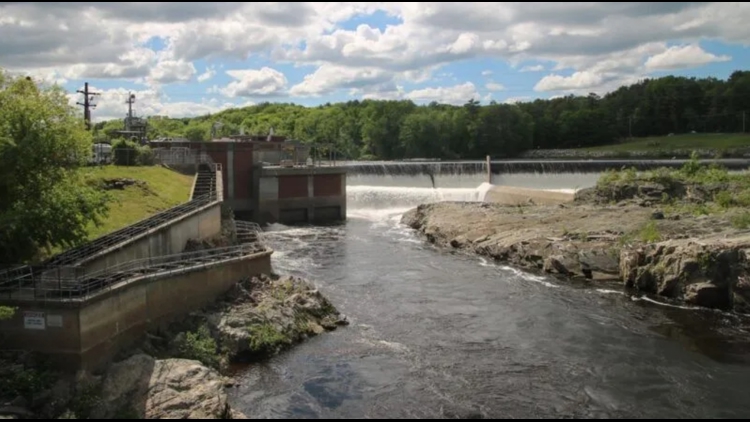MAINE, USA — Like floodwaters released during a breach, dam news in Maine seems to come all at once.
In the past month, a federal court reasserted Maine’s role in the relicensing of a major Kennebec River dam, a Downeast town secured funding for the removal of its aging ice retention dam, and the owners of three Bucksport-area dams announced intent to forfeit their ownership.
These shifts in the long-term management of all five dams lead back to a question that the state is addressing more and more often: What futures lie ahead for the structures that have shaped Maine’s environment and communities for centuries?
At the Shawmut Dam on the Kennebec River, its future will continue to involve Maine’s oversight.
Dam operator Brookfield Renewable had filed a petition in federal appeals court last year to boot Maine from the dam’s federal relicensing process after the state determined the dam would not safely pass fish, denying Brookfield a water quality certification that it needs for Shawmut’s license renewal.
Brookfield alleged that because Maine’s denial didn’t follow proper procedures, the need for the state’s approval was waived and relicensing could move along without it.
A federal appeals court in Washington D.C. rejected that argument, stating Maine’s denial was due in part to Brookfield’s delayed filing of application materials.
Brookfield now has to re-file its application for a state water quality certificate, according to an attorney with fisheries nonprofit Trout Unlimited, and is likely awaiting a final environmental impact statement from the Federal Energy Regulatory Commission before doing so.
Elsewhere on Maine’s rivers, years of neglected maintenance and shifting ownership have hastened the need for some Maine communities and dam owners to decide on their futures.
In Cherryfield, residents voted last November to remove an aging town-owned ice retention dam on the Narraguagus River, but the town and its nonprofit partners have lacked the funding to carry it out.
Now, with a $9.1 million grant from the National Oceanic and Atmospheric Administration, the Downeast Salmon Federation can fund the design process and eventually replace the dam with a nature-like fishway, the Bangor Daily News reported earlier this month.
The fishway will continue to reduce flooding and ease access for Atlantic salmon and alewives to valuable spawning grounds upstream: a common goal behind many dam removal campaigns in Maine.
Sustaining maintenance and upkeep grows even thornier when ownership of the dam itself is uncertain, a situation confronting local officials and residents in Bucksport and Orland.
There, corporate owners Bucksport Mill LLC and parent company AIM Demolition USA LLC abruptly announced they would be relinquishing ownership of three area dams, the BDN reported last week.
In addition to sustaining the water levels that residents have built around, each dam plays an important role on the three water bodies they occupy and all three are classified as “high” risk, meaning human lives are in danger if the dams fail.
The phrasing of the companies’ announcement was jarring for many residents, said Bucksport Town Manager Susan Lessard at a July 18 town council meeting.
“The part that makes me the most upset is that it has scared a lot of people,” Lessard said. “And that’s not right. There was a whole other way to approach this.”
The companies’ characterization that the Maine Department of Environmental Protection will “issue an order requiring the dam owner to release the water from the dam” if no owner is found skipped multiple steps in Maine’s required process, Lessard said.
State law mandates a 180-day consultation period between the dam owner and neighboring lake associations, residents abutting the dammed waterway, and local and state officials to determine whether someone else may want to assume ownership.
Then, if a new owner isn’t found, there’s a review process that tasks three Maine agencies to each take up to 60 days to determine a dam’s maintenance costs and public value. After review, the agency can either take ownership of the dam or notify the next agency to make the same judgment.
Only after this review process, when no new owner has been found, does the department order the owner to release the dam’s water in the least-impactful way.
Based on what the dams support on each waterway — like a drinking water supply, community property values, and a fish hatchery — Lessard seemed hopeful that they would be ascribed some sort of public good should the quest for a new owner fail.
She urged every entity involved to work together and ensure the owners comply with Maine’s process, reiterating what’s at risk without the dams.
“There can’t be a divide and conquer (approach) here. All the communities have some sense of where things could go bad if the dams were removed,” Lessard said. “And all of them … have people that are scared that these dams are going to go, that their properties are going to be worthless.”
This story was originally published by The Maine Monitor, a nonprofit and nonpartisan news organization. To get regular coverage from the Monitor, sign up for a free Monitor newsletter here.



